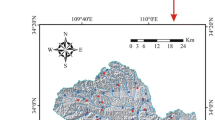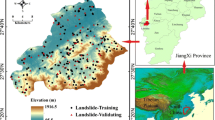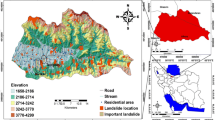Abstract
This study attempted to map land subsidence susceptibility using a support vector machine (SVM) model and their different kernel functions in Kerman province, Iran. Initially, land subsidence locations were recognized using extensive field surveys and Google Earth images and, subsequently, a land subsidence distribution map was created in a GIS environment. Then, different effective factors in the occurrence of land subsidence in the study area including percentage slope, slope aspect, altitude, profile curvature, plan curvature, topographic wetness index (TWI), distance from river, lithological units, piezometric changes, land use and normalized difference vegetation index (NDVI) were selected as independent variables for the modeling process. Land subsidence susceptibility maps in the study area were produced using an SVM model and different kernel functions related to it such as linear, polynomial, sigmoid and radial basis functions. The results of model validation using 30% of the unused locations in the modeling process and receiver operating characteristic (ROC) showed that the maps of land subsidence susceptibility obtained from the SVM technique and kernel functions had the highest accuracy with AUC values of 0.894 to 0.857. According to the results of prioritization of effective factors, piezometric data (utilization of groundwater), NDVI and altitude were the most significant factors affecting the occurrence of land subsidence in Kerman province. Therefore, the results of spatial modeling of land subsidence and their susceptibility maps have a key role in the planning of land allocation and water resource management in the study area.








Similar content being viewed by others
References
Al-Aboodi A, Ibrahim H, Al-Recabi W (2018) Stage-discharge relationship modeling using data mining techniques in an arid region. Int J Appl Eng Res 13:326–336
Auria L, Moro R (2008) Support vector machines (SVM) as a technique for solvency analysis. Deutsches Institut fur Wirtschaftsforschung 1–16
Azarbagh H (2014) Evaluation of the amount of soil restoration in the formation and development of gaps in Jiroft plain. Master's dissertation. Islamic Azad University Zahedan. Faculty of Sciences. 87pp [Persian]
Behzad M, Asghari K, Coppola EA (2010) Comparative study of SVMs and ANNs in aquifer water level prediction. J Comput Civ Eng 5:408–413
Bhavsar H, Ganatra A (2014) Increasing efficiency of support vector machine using the novel kernel function: combination of polynomial and radial basis function. International Journal on Advanced Computer Theory and Engineering (IJACTE) 3:17–24
Catani F, Lagomarsino D, Segoni S, Tofani V (2013) Landslide susceptibility estimation by random forests technique: sensitivity and scaling issues. Nat Hazards Earth Syst Sci 13:2815–2831
Chen W, Pourghasemi HR, Kornejady A, Zhang N (2017) Landslide spatial modeling: introducing new ensembles of ANN, MaxEnt, and SVM machine learning techniques. Geoderma:314–327
Conforti M, Pascale S, Robustelli G, Sdao F (2014) Evaluation of prediction capability of the artificial neural networks for mapping landslide susceptibility in the Turbolo River catchment (northern Calabria, Italy). Catena 113:236–250
Cortes C, Vapnik V (1995) Support-vector networks. J Mach Learn 20(3):273–297
Dai FC, Lee CF (2002) Landslide characteristics and slope instability modeling using GIS, Lantau Island, Hong Kong. Geomorphology 42(3–4):213–228
Fawcett T (2006) An introduction to ROC analysis. Pattern Recogn Lett 27(8):861–874
Ghorbanzadeh O, Blaschke T, Aryal J, Gholaminia K (2018a) A new GIS-based technique using an adaptive neuro-fuzzy inference system for land subsidence susceptibility mapping. J Spat Sci:1–17
Ghorbanzadeh O, Feizizadeh B, Blaschke T (2018b) An interval matrix method used to optimize the decision matrix in AHP technique for land subsidence susceptibility mapping. Environ Earth Sci 77(16):584
Ghorbanzadeh O, Rostamzadeh H, Blaschke T, Gholaminia K, Aryal J (2018c) A new GIS-based data mining technique using an adaptive neuro-fuzzy inference system (ANFIS) and k-fold cross-validation approach for land subsidence susceptibility mapping. Nat Hazards:1–21
Gonnuru P, Kumar S (2018) PsInSAR based land subsidence estimation of Burgan oil field using Terra SAR-X data. Remote Sensing Applications: Society and Environment (RSASE) 9:17–25
Guo Q, Liu Y (2010) Modeco: an integrated software package for ecological niche modeling. Ecography 33:637–642
Hall FG, Townshend JR, Engman ET (1995) Status of remote sensing algorithms for estimation of land surface state parameters. Remote Sens Environ 51:138–156
Hong H, Pradhan B, Jebur MN, Bui DT, Xu C, Akgun A (2016) Spatial prediction of landslide hazard at the Luxi area (China) using support vector machines. Environ Earth Sci 75:1–14
Jiao JJ, Leung CM, Ding G (2008) Changes to the groundwater system, from 1888 to present, in a highly-urbanized coastal area in Hong Kong, China. Hydrogeol J 16(8):1527–1539
Komac M (2006) A landslide susceptibility model using the analytical hierarchy process method and multivariate statistics in per-alpine Slovenia. Geomorphology 74:17–28
Kornejady A, Ownegh M, Bahremand A (2017) Landslide susceptibility assessment using maximum entropy model with two different data sampling methods. Catena 152:144–162
Lee S, Park I (2013) Application of decision tree model for the ground subsidence hazard mapping near abandoned underground coal mines. J Environ Manag 127:166–176
Lee S, Park I, Choi TK (2012) Spatial prediction of ground subsidence susceptibility using an artificial neural network. Environ Manag 49:347–358
Li Z, Zhou H, Xu Y (2013) Research on prediction model of support vector machine based land subsidence caused by foundation pit dewatering. Adv Mater Res 671-674:105–108
Lin Y, Yu H, Wan F, Xu T (2017) Research on classification of Chinese text data based on SVM. IOP Conference Series: Materials Science and Engineering, p 1–5
Liu L, Lei Y (2018) An accurate ecological footprint analysis and prediction for Beijing based on SVM model. Eco Inform 44:33–42
Mahmoudpour M, Khamehchiyan M, Nikudel MR, Ghassemi MR (2016) Numerical simulation and prediction of regional land subsidence caused by groundwater exploitation in the southwest plain of Tehran, Iran. Eng Geol 291:6–28
Mhetre P, Bapat MS (2015) Classification of teaching evaluation performance using support vector machine. International Journal of Latest Research in Science and Technology (IJLRST) 4:37–39
Micheletti N (2011) Landslide susceptibility mapping using adaptive support vector machines and feature selection. A Master Thesis submitted to University of Lausanne Faculty of Geosciences and Environment for the Degree of Master of Science in Environmental Geosciences, 99p
Moore ID, Grayson RB, Ladson A (1991) Digital terrain modeling: a review of hydrological, geomorphological, and biological applications. Hydrol Process 5:3–30
Motagh M, Walter TR, Sharifi MA, Fielding E, Schenk A, Anderssohn J, Zschau J (2008) Land subsidence in Iran caused by widespread water reservoir overexploitation. Geophys Res Lett 35:L16403. https://doi.org/10.1029/2008GL033814
Ozdemir A (2016a) Investigation of sinkholes spatial distribution using the weights of evidence method and GIS in the vicinity of Karapinar (Konya, Turkey). Geomorphology 245:40–50
Ozdemir A (2016b) Sinkhole susceptibility mapping using logistic regression in Karapınar (Konya, Turkey). Bull Eng Geol Environ 75(2):681–707
Park I, Lee J, Lee S (2014) Ensemble of ground subsidence hazard maps using fuzzy logic. Cent Eur J Geosci 6:207–218
Pourghasemi HR (2016) GIS-based forest fire susceptibility mapping in Iran: a comparison between evidential belief function and binary logistic regression models. Scand J For Res 31(1):80–98
Pourghasemi HR, Beheshtirad M (2015) Assessment of a data-driven evidential belief function model and GIS for groundwater potential mapping in the Koohrang watershed, Iran. Geocarto Int 30:662–685
Pourghasemi HR, Kerle N (2016) Random forests and evidential belief function-based landslide susceptibility assessment in Western Mazandaran Province, Iran. Environ Earth Sci 75:1–17
Pourghasemi HR, Goli Jirandeh A, Pradhan B, Xu C, Gokceoglu C (2013) Landslide susceptibility mapping using support vector machine and GIS at the Golestan Province, Iran. J Earth Syst Sci 122(2):349–369
Pourghasemi HR, Moradi HR, Fatemi Aghda SM, Gokceoglu C, Pradhan B (2014) GIS-based landslide susceptibility mapping with probabilistic likelihood ratio and spatial multi-criteria evaluation models (north of Tehran, Iran). Arab J Geosci 7:1857–1878
Pourhasemi HR, Moradi HR, Mohammadi M, Mostafazadeh R, Goli Jirandeh A (2013) Landslide hazard zonation using the Bayesian theory. Journal of Science and Technology of Agriculture and Natural Resources, Water and Soil Sciences 62:109–121 (In Persian)
Pradhan B, Abokharima MH, Jebur NM, Shafapour Tehrany M (2014) Land subsidence susceptibility mapping at Kinta valley (Malaysia) using the evidential belief function model in GIS. Nat Hazards 73:1019–1042
Vapnik V (1998) Statistical learning theory. Wiley, New York
Waltham AC (1989) Ground subsidence. Blackie, Glasgow
Xu YS, Shen SL, Ren DJ, Wu HN (2016) Analysis of factors in land subsidence in Shanghai: a view based on a strategic environmental assessment. Sustainability 8(6):573
Yesilnacar EK (2005) The application of computational intelligence to landslide susceptibility mapping in Turkey, Ph.D Thesis, Department of Geomatics the University of Melbourne, p 423
Yesilnacar E, Topal T (2005) Landslide susceptibility mapping: a comparison of logistic regression and neural networks methods in a medium scale study, Hendek region (Turkey). Eng Geol 79(3–4):251–266
Yilmaz I (2009) A case study from Koyulhisar (Sivas-Turkey) for landslide susceptibility mapping by artificial neural networks. Bull Eng Geol Environ 68(3):297–306
Acknowledgments
The authors would like to thank the Editor-in-Chief (Prof. Martin Gordon Culshaw) and two anonymous reviewers for their helpful comments on the primary version of the manuscript. The study was supported by the College of Agriculture, Shiraz University (grant no. 96GRD1M271143).
Author information
Authors and Affiliations
Corresponding author
Rights and permissions
About this article
Cite this article
Abdollahi, S., Pourghasemi, H.R., Ghanbarian, G.A. et al. Prioritization of effective factors in the occurrence of land subsidence and its susceptibility mapping using an SVM model and their different kernel functions. Bull Eng Geol Environ 78, 4017–4034 (2019). https://doi.org/10.1007/s10064-018-1403-6
Received:
Accepted:
Published:
Issue Date:
DOI: https://doi.org/10.1007/s10064-018-1403-6




